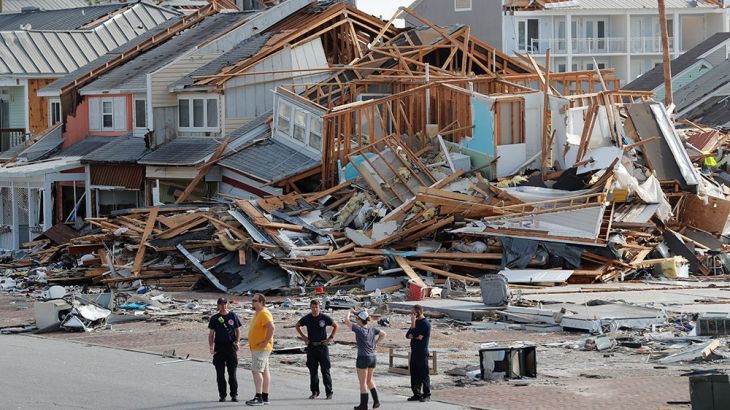Hurricane Michael rescue efforts continue as death toll rises
Over a million people are without power and the death toll is expected to climb, rescue officials say.

Search and rescue efforts continued in the southern United States as the death toll from Hurricane Michael rose to at least 17 by late Friday.
Deaths were reported by authorities in the East Coast states of Virginia, Florida, Georgia and North Carolina.
Keep reading
list of 4 itemsAt least 50 killed in heavy rains, floods in Afghanistan’s Ghor province
Rainfall set to help crews battling wildfire near Canada’s Fort McMurray
Canada wildfires spur evacuation orders, warnings: What you need to know
Brock Long, head of the Federal Emergency Management Agency (FEMA) told CNN on Friday he expects “the fatality count to climb today and tomorrow … Hopefully it doesn’t rise dramatically but it does remain a possibility”.
The Category 4 storm smashed into Florida’s northwest coast near the small town of Mexico Beach on Wednesday with 250km per hour winds, uprooting trees and leveling buildings.
US Army personnel used heavy equipment to push a path through debris in Mexico Beach to allow rescuers to search for trapped residents, survivors or casualties, as Blackhawk helicopters circled overhead.
FEMA personnel used dogs, drones and GPS in the search.
Video shot by CNN news network from a helicopter showed homes closest to the water in Mexico Beach had lost all but their foundations. A few blocks inland, about half the homes were reduced to piles of wood and siding, while those still standing had suffered heavy damage.
Losses could reach $4.5bn, according to an insurance trade journal.
More than 1.4 million utility customers from Florida to Virginia were without power as of Friday morning, according to a website that tracks outages.
The number of people in emergency shelters was expected to swell to 20,000 across five states by Friday, said Brad Kieserman of the American Red Cross.
![Homes destroyed by Hurricane Michael are shown in this aerial photo in Mexico Beach [Chris O'Meara/AP Photo]](/wp-content/uploads/2018/10/1cd398b552a542b48ab8576c95fdee73_18.jpeg)
At Jinks Middle School in Panama City, near Mexico Beach, the storm peeled back part of the gym roof and tore off a wall. A year ago, the school welcomed students and families displaced by Hurricane Maria in Puerto Rico.
“I have had employees going to the communities where our kids live, going door to door and checking,” said Principal Britt Smith told Reuters by phone. “I have been up since 3:30 or 4am emailing and checking on staff to see if they are safe. So far, everybody seems to be very safe.”
Damage ‘way worse’ than expected
Florida Governor Rick Scott told the Weather Channel the damage from Panama City down to Mexico Beach was “way worse than anybody ever anticipated”.
Michael pummeled communities across the Panhandle and turned streets into roof-high waterways.
About 32km south of Mexico Beach, floodwaters were more than 2.1 metres deep near Apalachicola, a town of about 2,300 residents, NHC Director Ken Graham said. Wind damage was also evident.
“Our biggest thing is the downed lines and the downed trees,” said Apalachicola Mayor Van Johnson.
![People cut away a tree that'll on a vehicle in the aftermath of Hurricane Michael in Panama City[Gerald Herbert/AP Photo]](/wp-content/uploads/2018/10/253a67ae32454e3393229ca7ee496b0e_18.jpeg)
Brad Rippey, a meteorologist for the US Agriculture Department, said Michael severely damaged cotton, timber, pecans and peanuts, causing estimated liabilities as high as $1.9bn and affecting up to 1.5 million hectares.
Michael also disrupted energy operations in the US Gulf of Mexico as it approached land, cutting crude oil production by more than 40 percent and natural gas output by nearly one-third as offshore platforms were evacuated.
The weakened storm, no longer a hurricane, has moved over the Atlantic Ocean, its remnants still lashing northeastern US states in New England with strong winds and heavy rain.